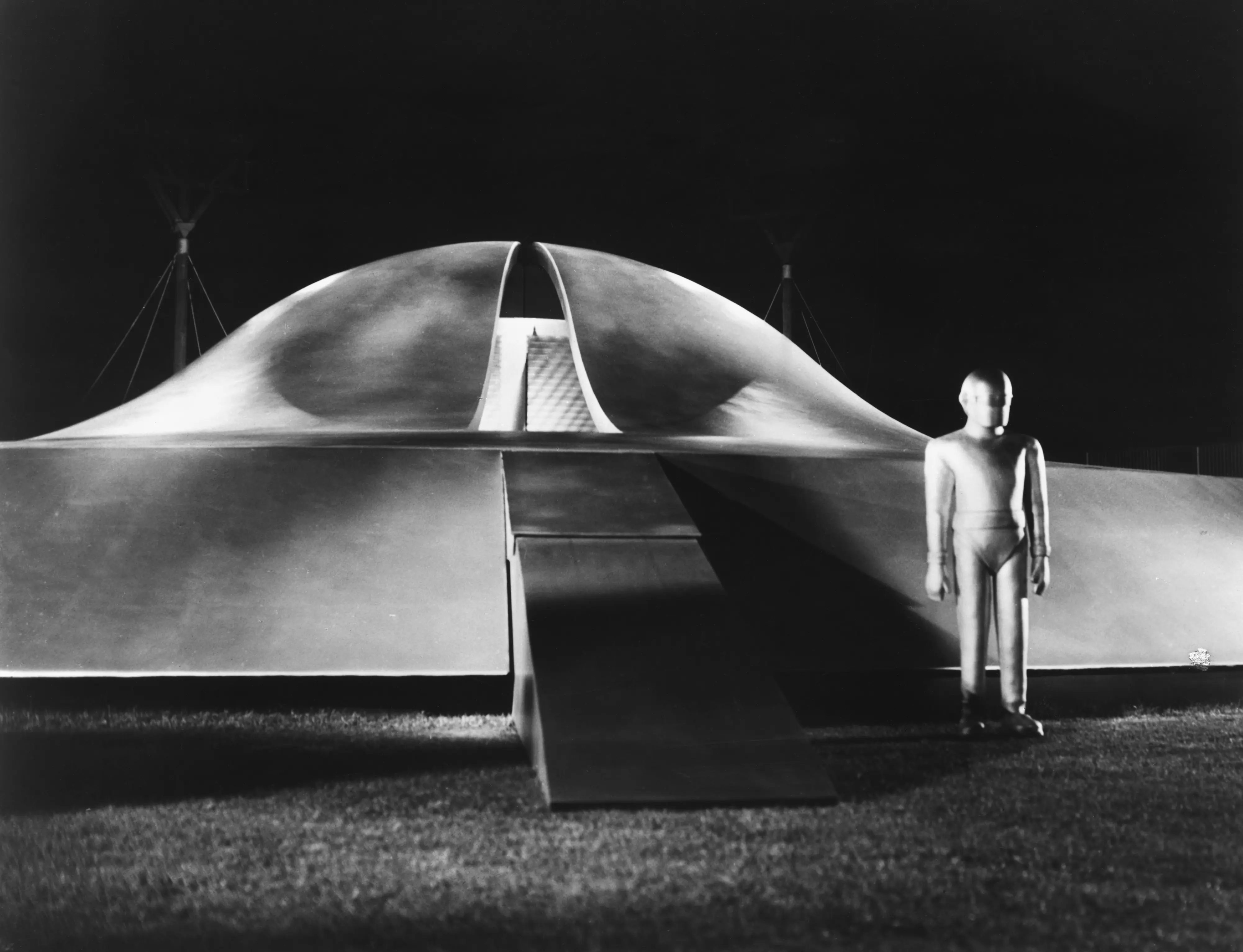Unexplained flashes of light found in 70-year-old sky photos raise new questions: Were they caused by UFOs or nuclear tests?
-
 Gort standing by his spacecraft in a scene from The Day the Earth Stood Still. (Photo by �� John Springer Collection/CORBIS/Corbis via Getty Images)
Gort standing by his spacecraft in a scene from The Day the Earth Stood Still. (Photo by �� John Springer Collection/CORBIS/Corbis via Getty Images)A new study has reopened debate about a string of strange bursts of light that were caught in historic astronomical photographs. The lights, initially seen over 70 years ago, have long mystified scientists.
New research indicates that the flashes may have been triggered by either UFO activity or early nuclear explosions — or both.
The research, which appeared in Acta Astronautica, examines data from 1950s sky surveys when astronomers had observed brief, inexplicable flashes of light appearing and vanishing in a matter of seconds.
The brief flashes did not resemble any known astronomical events like supernovas or meteors, and experts have been left grappling for an explanation ever since.
What the study found
The research team re-examined a sequence of photographic plates from the Palomar Observatory Sky Survey that had taken broad swaths of the night sky in the middle of the 20th century.
The photographs showed nine bright spots that appeared and then disappeared without leaving a trace in subsequent exposures.
When researchers compared the plates shot minutes apart, the enigmatic flashes existed in one photo but were entirely absent in the next — an unusual phenomenon in astronomy.
The authors of the new paper, headed by Nordic Institute for Theoretical Physics' Beatriz Villarroel, believe that these lights have two possible explanations: unidentified aerial phenomena (UAPs) — so-called UFOs — or light bursts from nuclear explosions conducted in the early days of the Cold War.
The nuclear connection
In the 1950s, many nations, including the Soviet Union and the United States, were testing nuclear weapons in the atmosphere.
The blasts were so brilliant that they could be observed hundreds of miles away and frequently dumped energy into the upper atmosphere.
The research indicates that these nuclear explosions could have produced some of the flashes seen in the photos of the sky, reflecting off the atmosphere or producing optical phenomena that were imaged by telescopes.
This explanation is bolstered by timing: several of the odd flashes correspond to years of intense nuclear testing.
Scientists also note that the flashes were intense and brief — a trend that corresponds with the light flashes from nuclear activity compared to natural cosmic activity.
The UFO theory
But nuclear tests may not account for everything. A few of the flashes were seen in areas of the sky and at times not accounted for by any known test records.
This has prompted scientists to speculate that a few of the lights could be connected to UFO activity.
During the period, sightings of unidentified flying objects were prevalent, and the Cold War years brought enhanced focus to both military aircraft and possible extraterrestrial observations.
Villarroel's group doesn't assert these were UFOs from another world, but they believe it's conceivable that unidentifiable aerial technology — human or otherwise — might have been behind some of the observed lights.
Their study indicates that the most likely explanation may be more than one — with some of the flashes caused by nuclear tests, while others may be related to atmospheric or unexplained aerial phenomena.
Why these results are important
The research demonstrates how ancient astronomical data may still yield new finds.
Scientists are now applying computerized image analysis to revisit historic sky surveys, looking for patterns that were not recognized decades earlier.
By comparing information from various observatories, researchers hope to figure out whether the flashes were local to Earth's atmosphere or not.
The results also might help reveal new types of transient events — fleeting flashes that don't fit into standard astronomical categories.
Still more questions than answers
For now, there is no clear conclusion about what caused the mysterious lights. They might have been reflections, nuclear tests, or something else entirely.
What’s certain is that the flashes were real — they appeared on multiple photographs taken by different telescopes.
As scientists continue to analyse the old data, they hope to understand what kind of phenomena can create such bright, short-lived bursts of light in the sky.
The mystery of the 70-year-old sky flashes remains unsolved, but it continues to show how science, history, and a bit of curiosity can come together to uncover new questions about the world — and the universe — around us.
TOPICS: UFO